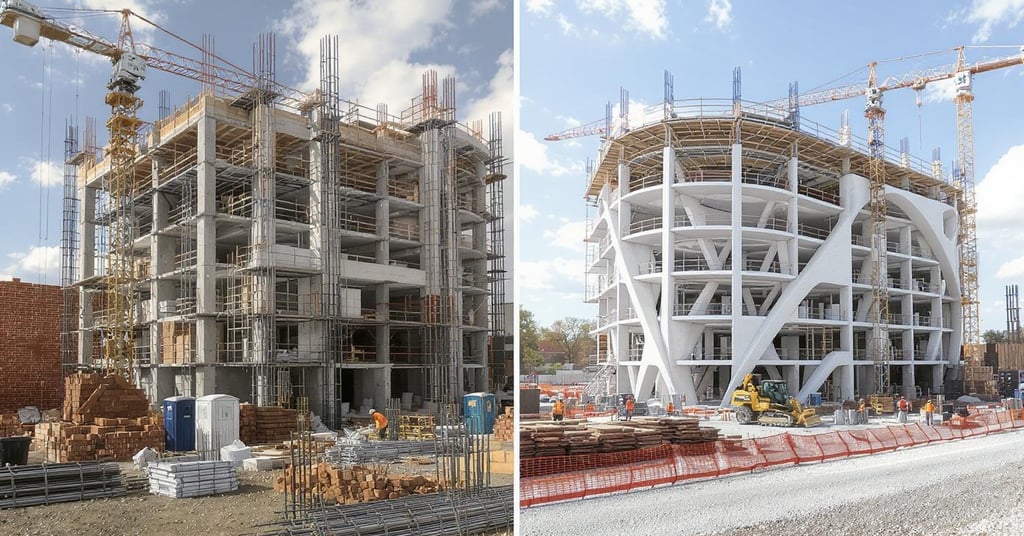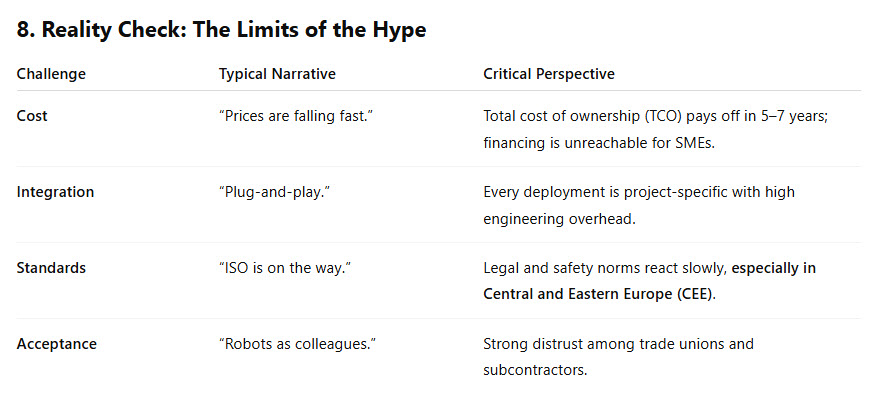Quality and technology IN CONSTRUCTION
delivered with STRAIGHT communication
Industrial Robotics and Automation on Construction Sites – Beyond the Hype, Toward Value Creation
Construction robotics is growing fast, driven by labour shortages and efficiency needs. While robots boost speed and safety, real progress depends on clear regulation, open data, and skilled operators—not just hype.
CONSTRUCTIONTRENDPROJECTMANAGEMENTFUTUREROBOTIC
Dr. Toldy Gábor - Toldy Construct
7/23/20253 min read


“One construction job indirectly generates two additional jobs.”
– Dr. Gábor Toldy – Architect, Data Scientist, Economist-Lawyer
1. The Robot Revolution Has Arrived – But Why Now?
The global construction robotics market has surged from USD 168 million in just three years and is projected to reach USD 774 million by 2032 – nearly a 17% annual growth rate. The driving forces are clear: chronic labor shortages, wage pressure, and increasingly strict safety requirements. A 2023 European industry survey reported that 67% of companies face labor shortages, while 81% simultaneously deal with soaring material and energy costs (Highways Today).
Without robots, deadlines and costs spiral – today, this is not merely a technological choice but a business necessity.
2. The 2025 Toolbox: From Robotic Arms to LiDAR-Guided Dozers
A brick wall in four hours? The Hadrian X robot built the walls of two family homes in Florida in a single shift with only three operators – the goal: 10 houses in a demonstration program (Inspenet).
Drywalling 60% faster. With the Canvas 1200CX robot, the joint-compound and sanding cycle was cut from 5–7 days to just 2, with 99% of dust captured – turning an ergonomic nightmare into a data-driven workflow (Canvas).
Self-driving bulldozers – no longer sci-fi. 47% of companies today use pilot or operational autonomous dozers and haulers, which move 38% more material per hour than those operated manually (globalgrowthinsights.com).
3. Academic Perspective: ETH Zurich and the “Digital In-Situ” Paradigm
According to 2023–25 publications from the Gramazio-Kohler research group at ETH Zurich, on-site robotic 3D printing and soil-based additive manufacturing are no longer lab curiosities, but system-level prototypes. Adaptive robotic compaction and 4D formwork technologies now enable the casting of complex concrete forms under real industrial conditions (gramaziokohler.arch.ethz.ch).
The key: robots not only execute but learn from real-time sensor data, increasingly merging the design and construction cycles.
4. Data, AI, Predictive Maintenance
Sensor fusion + machine learning = zero downtime?
Recent trials with sensor-equipped robot arms track joint vibration patterns in real-time and estimate remaining lifespan – enabling failure prevention hours, not days, in advance (MDPI).
In business terms: an extra day of downtime for an expensive machine can eat away 1–2% of project margins; predictive operation makes this risk manageable.
5. The Productivity Paradox
As McKinsey’s 2024 analysis reveals: between 2000 and 2022, global construction productivity grew by only 10%, while manufacturing surged 90%. Even worse: from 2020 to 2022, the sector suffered an 8% decline (McKinsey & Company).
If robotics doesn’t accelerate soon, the industry won’t be able to meet the projected USD 22 trillion global demand by 2040 – a 70% increase.
Key question: Will machine-generated data really boost that sluggish productivity curve, or are we just entering the next chapter of the "pilot inferno"?
6. Job Loss vs. Quality Employment
According to OECD forecasts, generative AI and robotics will mainly replace dangerous, repetitive tasks in construction, while demand will rise for complex manual, supervisory, and data-oriented roles (OECD).
However, in the domestic market, the dramatic shortage of skilled labor and widespread underqualification represent both risk and opportunity:
If we fail to act now, “two-speed Europe” will become entrenched in the robotics arena as well.
7. No Robots Without Regulation and Transparency
In his doctoral, legal, and economic works, Dr. Gábor Toldy consistently emphasizes: the Hungarian construction sector operates in “black-and-white mode” due to poor contracting culture, opaque procurement, and weak advocacy by professional chambers.
Robotics here hits a double barrier:
Capital-intensive: It only pays off in a regulated, predictable market environment.
Data-intensive: Ownership and cybersecurity of sensor-generated data remain a grey zone.
Unless public procurement and building regulations quickly address the machine–data–human trilemma, the technology will either leak abroad or be monopolized – neither outcome fosters innovation.


9. What Can a Hungarian Policymaker or General Contractor Do?
Pilot, not sandbox: Three pilot projects – three different use cases (prefab, on-site, data monitoring), with measurable KPIs.
RegTech sandbox: A joint NGM–ÉMI framework for robot-data governance; like a fintech sandbox, but concrete-scented.
Chamber credit system: Robot operator reskilling should be part of mandatory continuing education, with subsidized certification.
Promote open data standards: Integrate robot telemetry with BIM, enabling small firms to join the value chain.
10. The Future: A Cooperative Ecosystem
Industrial robots are no longer “futurist showpieces” – they are data-driven production assets.
Those who act now will gain productivity and safety; those who delay risk shrinking margins and delayed projects.
But – and here comes the Toldy lens – real, sustainable breakthroughs will only come if the technological hype is matched by regulatory and industry transparency.
Construction
With over 20 years of experience in general contracting, our company specializes in the flawless execution of unique, bespoke buildings. Our innovative methods and mindset make us stand out in the market.
Our services
Contacts
company@toldyconsult.hu
+36 30 289 2383
© 2024. All rights reserved.
Our WEBPAGES
www.toldyconsult.hu
